You'll find five exceptional oils that excel at preserving vegetables: extra virgin olive oil, garlic-infused acidified oil, cold-pressed grapeseed oil, herb-enhanced sunflower oil, and vinegar-oil blends. Each option offers unique benefits – olive oil provides antioxidant protection, acidified garlic oil adds flavor while ensuring safety, grapeseed oil maintains a neutral taste with impressive shelf life, sunflower oil pairs beautifully with herbs, and vinegar-oil blends create the perfect preservation environment. Store your oil-preserved vegetables in clean, dark containers at ideal temperatures between 57-68°F, and you'll discover a world of flavor-packed preservation techniques waiting to transform your kitchen.
Extra Virgin Olive Oil

Anyone who's invested in quality extra virgin olive oil knows proper storage is crucial for maintaining its distinctive flavor and nutritional benefits.
You'll want to keep your oil at temperatures between 57°F and 68°F, as this range effectively slows down oxidation and preserves quality. Don't store it near your stove or oven, as heat accelerates degradation. Always keep bottles tightly sealed after each use to prevent oxidation from occurring.
Your storage container choice matters considerably. Always opt for dark glass or ceramic containers that block harmful UV rays, and avoid plastic containers that can contaminate your oil.
After opening, you should transfer your oil to smaller containers to minimize oxygen exposure, which can quickly diminish its quality.
You'll get the best results if you use your opened oil within 30-60 days, though unopened bottles can last up to two years from harvest.
Don't save expensive oils for special occasions – they're best enjoyed fresh. Instead, buy smaller amounts you can use within the recommended timeframe.
While refrigeration isn't necessary for stable temperatures, you can refrigerate excess oil for long-term storage, though it may solidify.
Remember to check the harvest and "Best By" dates before purchasing to guarantee maximum freshness.
Garlic-Infused Acidified Oil
Creating garlic-infused oil safely requires careful acidification of the garlic first to prevent dangerous botulism growth.
You'll need to soak your garlic in citric acid solution until it reaches a pH of 4.2 or lower within 24 hours, keeping the cloves fully submerged during this process. Always use specialized lab equipment to accurately measure the water activity in your garlic. After draining the acid solution, you can begin the infusion process.
To infuse your oil, combine 1 part acidified garlic with 10 parts oil at room temperature. You can let it infuse for 1-10 days, or speed up the process by heating the oil to 140°F for 5 minutes before adding the garlic.
Once you've achieved your desired flavor intensity, remove the garlic to prevent over-infusion.
When storing your garlic-infused oil, you'll want to keep it in a clean, dark-colored, food-grade container.
While refrigeration isn't required for acidified garlic oil, storing it in a cool, dark place will help maintain its quality longer.
Remember that non-acidified garlic oil must be refrigerated and used within 2-4 days, but your properly acidified version is safe for long-term shelf storage when you've followed these preparation steps correctly.
Cold-Pressed Grapeseed Oil

Three key qualities make cold-pressed grapeseed oil an excellent choice for vegetable storage: its neutral flavor, high smoke point, and impressive shelf life.
When properly stored in a cool, dark place between 50-70°F, your unopened cold-pressed grapeseed oil can last up to two years while maintaining its nutritional benefits and antioxidant properties. The oil's vitamin E content helps preserve its freshness and supports immune function.
To maximize your oil's longevity and quality, remember these essential storage tips:
- Transfer your oil to an opaque or dark glass container to protect it from light exposure and oxidation.
- Keep the container tightly sealed and stored away from heat sources like your stove or other appliances.
- Label your container with the purchase or opening date to track its shelf life effectively.
- Consider refrigeration for opened bottles to extend shelf life from 3-6 months to up to 12 months.
You'll know your grapeseed oil has maintained its quality when it remains clear and odorless.
If you notice any rancid smell, unusual cloudiness, or off-taste, it's time to replace it.
While freezing can extend shelf life up to two years, it might affect the oil's texture and flavor, so refrigeration is often the better choice for long-term storage.
Herb-Enhanced Sunflower Oil
Infusing sunflower oil with herbs demands careful attention to food safety and storage practices. When you're creating herb-enhanced sunflower oil at home, you'll need to follow strict storage guidelines to prevent bacterial growth, particularly Clostridium botulinum, which can cause botulism.
If you're using fresh or dried herbs in your sunflower oil, you must refrigerate the mixture and use it within four days, or freeze it for long-term storage. You'll want to label your containers with both the preparation date and use-by date to guarantee safety.
While commercial herb-infused oils are safely acidified, don't attempt to acidify your homemade mixtures without proper research.
Store your base sunflower oil in airtight containers in a cool, dark place, where it'll last up to two years unopened or six months after opening.
When adding herbs, you've got two safe options: either remove the herbs immediately after flavoring or store the mixture in the refrigerator. If you're using dried herbs or vegetables, you can keep the oil at room temperature, as these don't support bacterial growth.
For the best results, minimize how often you open the container to reduce air exposure.
Vinegar-Oil Preservation Blend
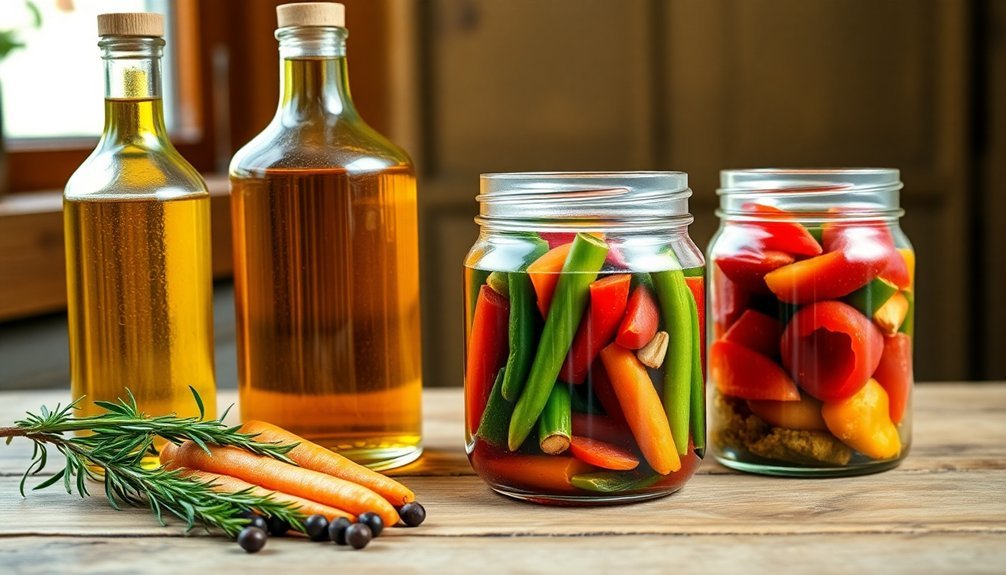
The preservation of vegetables in a vinegar-oil blend offers both flavor enhancement and extended storage life. When creating your marinade, combine two parts olive oil with one part vinegar, ensuring your vegetables remain completely submerged in this mixture.
You'll need to store your preserved vegetables in clean, sterile jars and keep them refrigerated to prevent bacterial growth.
- Choose your vegetables wisely – beets, tomatoes, zucchini, and mushrooms work exceptionally well, but cooked vegetables are safer than raw ones for long-term storage.
- Add flavor enhancers like smashed garlic cloves, lemon zest, and fresh herbs, but remember to remove raw ingredients within a week if you're planning longer storage.
- Pay attention to safety – you'll need to watch for air bubbles and remove them before refrigeration to prevent oxidation.
- Monitor storage time carefully – don't keep your preserved vegetables longer than 1-3 months, depending on your preservation method.
When you're ready to serve, let the oil return to room temperature if it's hardened in the fridge. You can use your preserved vegetables in salads, pasta dishes, sandwiches, or on charcuterie boards.
Remember to top off the oil-vinegar mixture when returning vegetables to storage.
Frequently Asked Questions
Can I Reuse the Oil After the Preserved Vegetables Are Consumed?
Yes, you can reuse the oil after consuming preserved vegetables. Just filter it through cheesecloth to remove food particles, store it in a dark container, and use it for cooking within its recommended reuse limit.
How Do I Know if My Preserved Vegetables Have Gone Bad?
Check for mold, sliminess, or bulging lids. If you notice offensive odors, unnatural colors, or bubbling liquid, don't consume them. Trust your senses – if something seems off, it's best to discard them.
Should I Sterilize Vegetables Before Preserving Them in Oil?
Yes, you must sterilize vegetables before preserving them in oil. Cook them thoroughly and guarantee they're acidified with vinegar or lemon juice. This kills harmful bacteria like C. botulinum and makes preservation safer.
What Causes Cloudiness in My Oil-Preserved Vegetable Mixture?
If you're seeing cloudiness in your preserved vegetables, it's likely due to moisture content, trapped water droplets, or temperature changes. When you store your mixture below 54°F, the oil naturally becomes cloudy.
Does the Oil's Smoke Point Affect Its Preservation Qualities?
Yes, an oil's smoke point matters for preservation. You'll find that oils with higher smoke points are more stable and resist oxidation better, making them better preservatives than low smoke point oils that degrade quickly.
In Summary
You'll find these five oils are reliable allies in extending your vegetables' shelf life. Whether you're using extra virgin olive oil for Mediterranean produce or experimenting with garlic-infused blends, proper oil preservation can keep your harvest fresh for months. Remember to always sterilize your containers and monitor for any signs of spoilage. With these oil options at your disposal, you're well-equipped to reduce food waste and enjoy your vegetables longer.
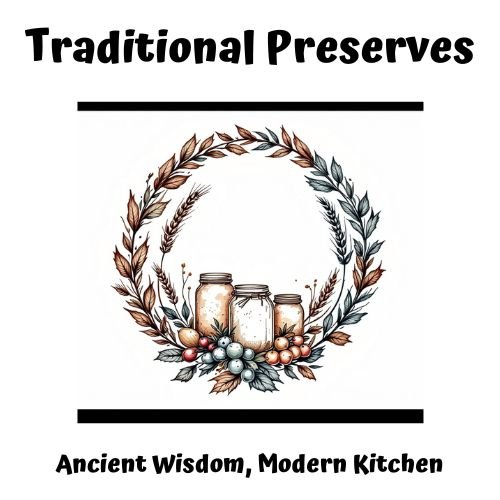
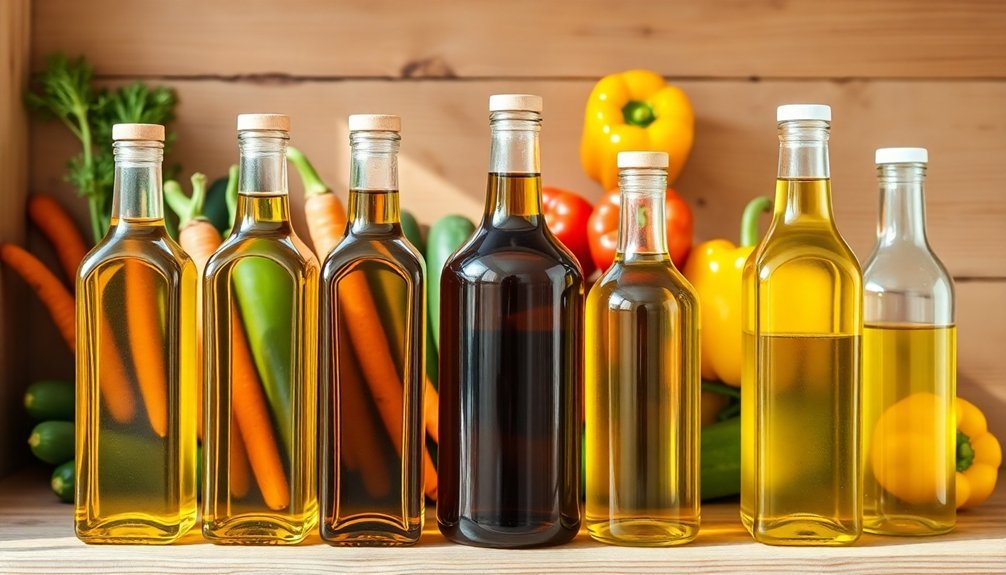
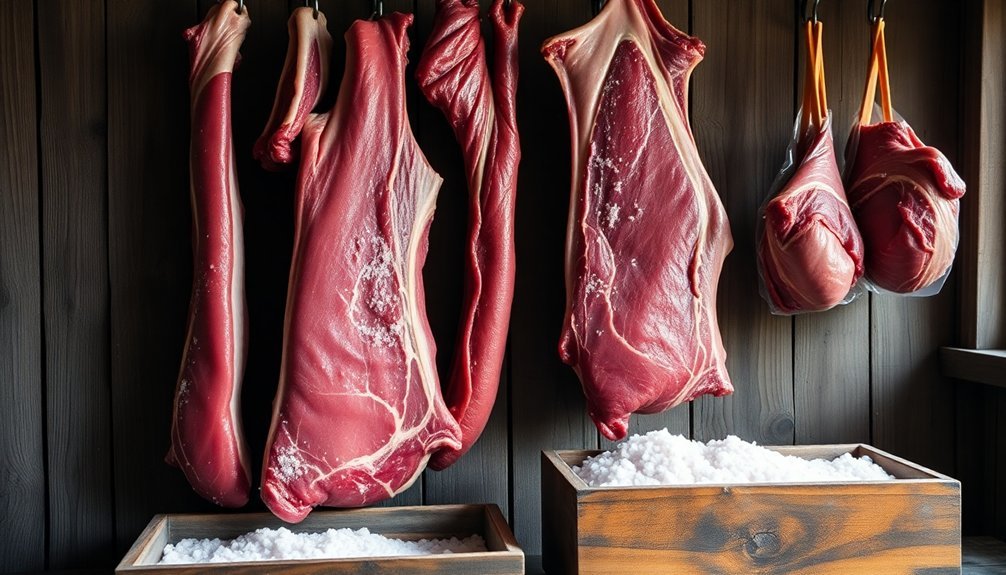
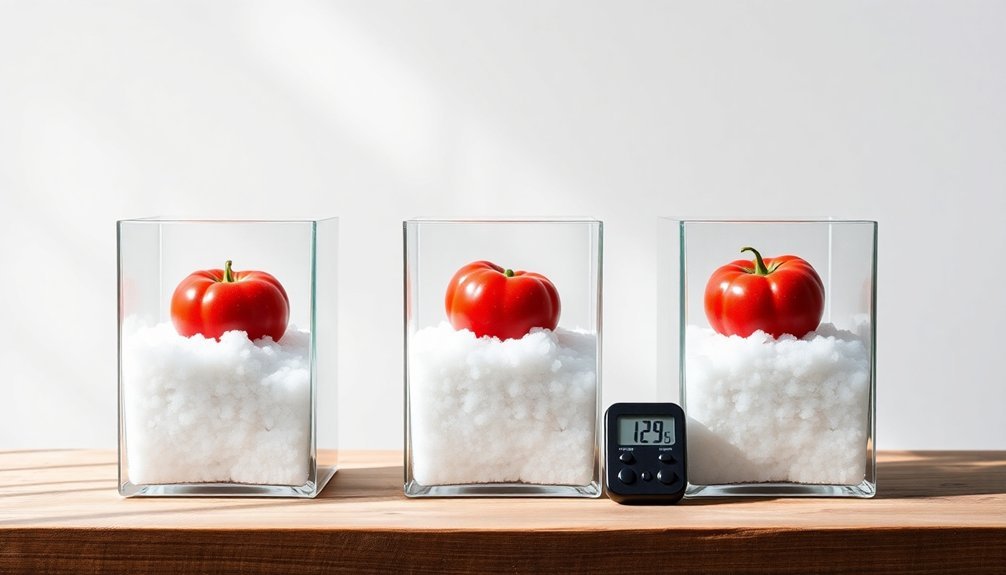
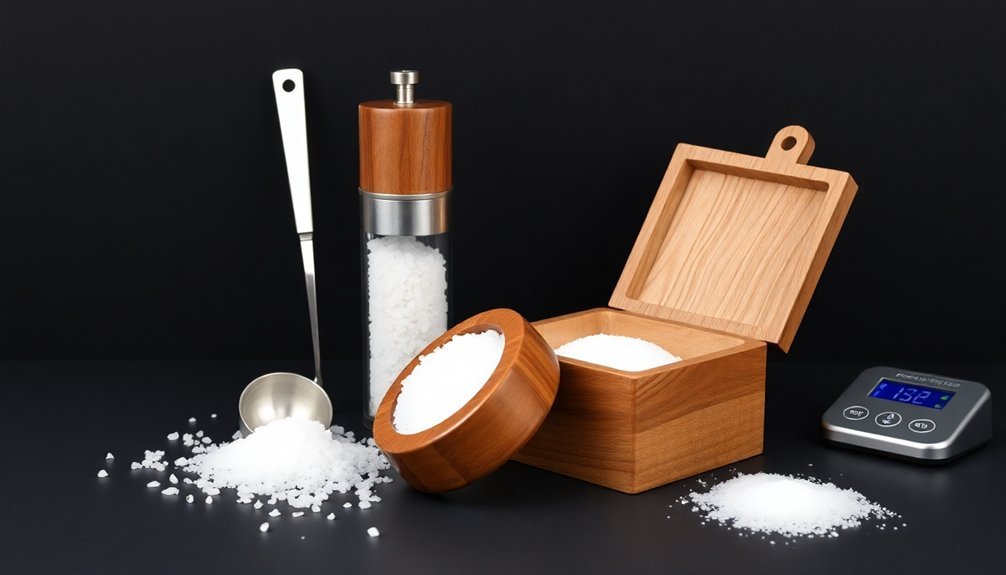
Leave a Reply